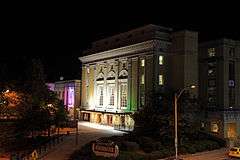Downtown Durham Historic District
|
Downtown Durham Historic District | |
|
Carolina Theatre, Downtown Durham Historic District, September 2010 | |
  | |
| Location | Roughly bounded by Peabody, Morgan, Seminary, Cleveland, Parrish, and Queen Sts., Durham, North Carolina |
|---|---|
| Coordinates | 35°59′42″N 78°54′01″W / 35.99500°N 78.90028°WCoordinates: 35°59′42″N 78°54′01″W / 35.99500°N 78.90028°W |
| Area | 0 acres (0 ha) |
| Architect | Multiple |
| Architectural style | Late 19th And 20th Century Revivals, Art Deco |
| NRHP Reference # | 77000998[1] |
| Added to NRHP | November 1, 1977 |
Downtown Durham Historic District is a national historic district located at Durham, Durham County, North Carolina. The district encompasses 97 contributing buildings and 1 contributing structure in the central business district of Durham. The buildings primarily date from the first four decades of the 20th century and include notable examples of Colonial Revival, Italianate, and Art Deco architecture. Notable buildings include the St. Philip's Episcopal Church (1907), Trinity Methodist Episcopal Church (1880-1881), First Baptist Church (1926-1927), Durham County Courthouse (1916), Durham Auditorium (Carolina Theatre, 1920s), Tempest Building (1894, 1905), National Guard Armory (1934-1937), United States Post Office (1934), Trust Building (1904), First National Bank Building (1913-1915), Mechanics and Farmers Bank (1921), Johnson Motor Company showroom (1927), Hill Building (1935), Snow Building (1933), and S. H. Kress store.[2][3]
It was listed on the National Register of Historic Places in 1977.[1]
References
- 1 2 National Park Service (2010-07-09). "National Register Information System". National Register of Historic Places. National Park Service.
- ↑ H. McKelden Smith and John B. Flowers (n.d.). "Downtown Durham Historic District" (pdf). National Register of Historic Places - Nomination and Inventory. North Carolina State Historic Preservation Office. Retrieved 2014-11-01.
- ↑ Cynthia de Miranda (June 2012). "Downtown Durham Historic District Additional Documentation" (pdf). National Register of Historic Places - Nomination and Inventory. North Carolina State Historic Preservation Office. Retrieved 2014-11-01.


